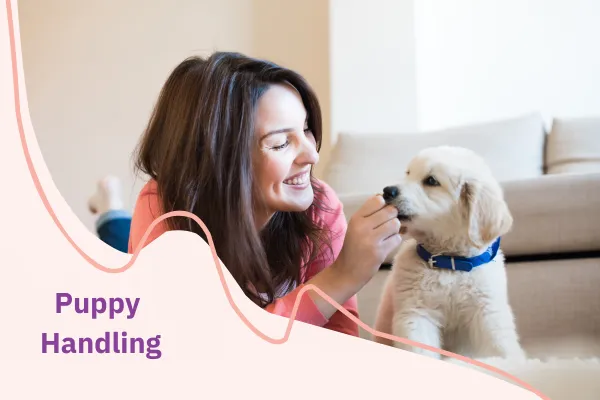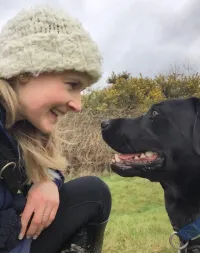
Getting Your Puppy Used to Handling - What Does It Mean?
Handling Comfort as Well as Building Social Connection!
So you probably spend a lot of time giving your dog affection and knowing which area they love you to scratch! This kind of interaction is enjoyable for you both, and it is likely to happen regularly. This is social connection and not what we would term as ‘handling’.
When we talk about ‘handling’ this can be considered to be more formal, more like a health check or if you need to place equipment on your dog. Grooming and vet checks for example are going to be carried out throughout a dog’s life and it will be a much more pleasant experience if your puppy is relaxed, tolerant and calm.
In our puppy classes we encourage owners to practice a daily health check and handling exercise with their puppies. In order to build a trusting relationship with a puppy we need to respond to what our puppies are telling us. Puppies do not speak to us in our language, but if we watch their body language it tells us a lot!!! If, for example, we went to pick up our puppy’s paw and they moved their paw away from us, that is a clear sign they do not feel comfortable with it and we should therefore spend time breaking the action down into smaller actions. Such as, a light touch on the paw followed by a tasty treat, this will help the puppy to feel more positive about his paw being touched.By practicing this exercise regularly and gradually extending this practice to all areas of their body you will be preparing your puppy for their first trip to the vets or groomers.

It is also a great idea to practice some calm, positive associations with a brush. It is so important to do this gradually so your puppy has a good experience with a brush and will be used to being groomed by you, prior to going to the groomers. Below is a lovely example of the handler practicing slow, calm movements with the brush and rewarding very well with some tasty treats, the result is shown in the puppies relaxed body language.
Equipment: Don't forget about your puppies walking equipment. This can also be introduced gradually and will ensure that your puppy is comfortable in their collar, harness or coat. The below video shows some ideas to help you introduce a harness positively to your puppy. The stages should be practiced in short sessions and only progressed if your puppy's body language is relaxed and positive like the dog in this video. If your dog or puppy is backing away or running away from the harness, or growling/snapping when it is placed near them, they likely are already worried by the equipment and you would likely need some help from a professional dog trainer/behaviourist.
Nail/ claw care is also super important!!! Keeping your dog's claws at an appropriate length will contribute to your dog's comfort. The nail embeds into the last digital bone, so whatever happens with the nail taps into the bone. Therefore long nails permanently engaging in the floor may put pressure on this bone, which can make the dog feel uncomfortable. Additionally the nails supply information to the brain about where the foot is, if the nails are permanently engaged it may give the message to the brain that the dog needs to rock backwards because they are on a slope and may therefore even change their overall body posture.
Groomers will want to trim your puppy or dogs nails so why not help your puppy prepare for this by getting them used to the nails being touched and gradual pressure being applied. Have a look at how easy it is to do in my video below.
If you do all this work helping your puppy feel confident with handling experiences it is vital that you select a groomer for your puppy that will focus on providing a positive first experience!
Some things to consider when making your choice of groomer;
Groomers that are keen to make the experience as positive for a young puppy as possible will offer puppy settling sessions. Often these are free or discounted sessions focused solely on giving your puppy a chance to explore the grooming salon and build a nice connection with the groomer.
Groomers that uphold fear free methods will only do what your puppy is comfortable with in the first few sessions and it is better that they say for example ' I was unable to trim the hair around your puppies eyes today as they were uncomfortable'.
Feedback from your groomer is great information for your and means you can go and practice touching around the eye area and feeding treats to your puppy to build up their confidence of people touching this area of their body slowly.
When you visit check with your groomer how many puppies/dogs would be in the salon at one time and how they would be secured during this time. Some groomers use crates, if your puppy has never been in a crate before then this could be a very worrying experience for them.
Another option is to find a mobile groomer that comes to your home in a van. It may be possible to stay with your puppy and help them build in confidence with the grooming experience.
If you need any help with handling your puppy/dog, whether it be grooming or getting your them comfortable in a harness or used to wearing a muzzle. Book a discovery call!

My Complex Canine offers professional puppy training classes (Puppy School Hartfield and Puppy School Lingfield) and supportive private dog training programs. Owner Sarah Worth is a registered ABTC training instructor and practices science-led ethical training methods.
(c) My Complex Canine 2026. Privacy Policy | Terms and Conditions | Terms and Conditions of Service | Sitemap
